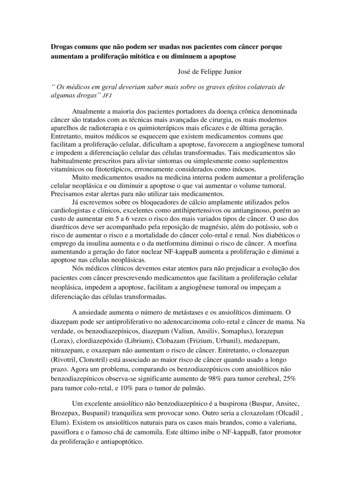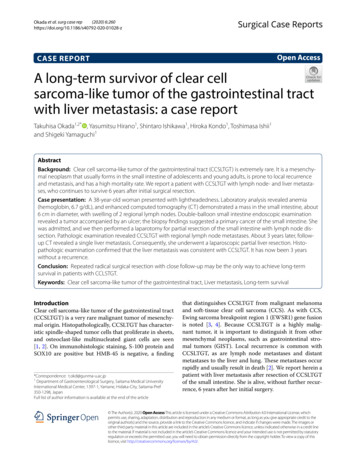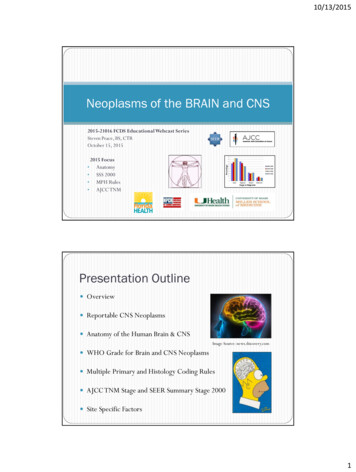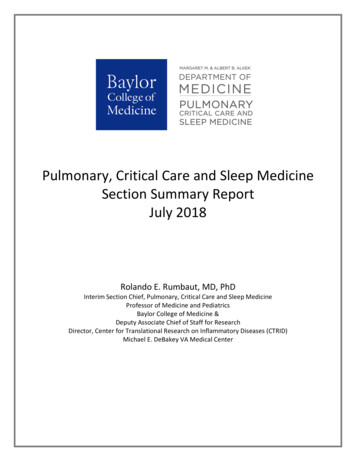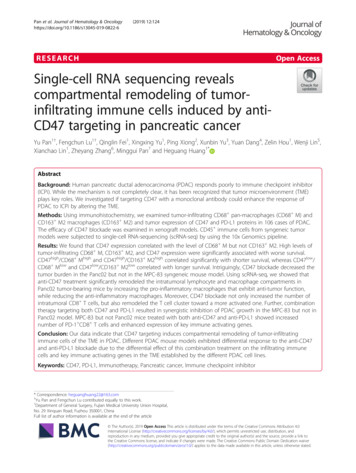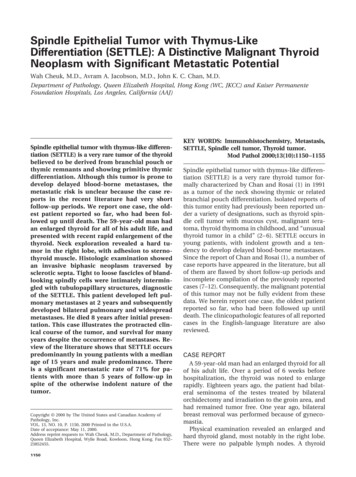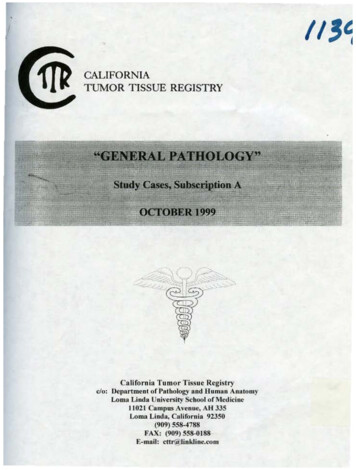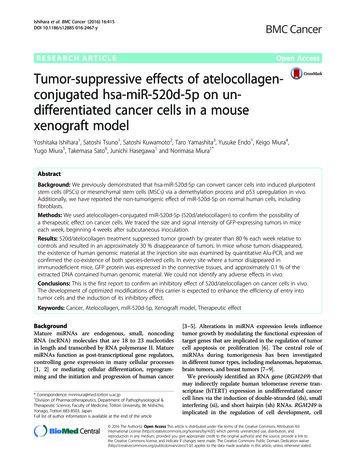
Transcription
Ishihara et al. BMC Cancer (2016) 16:415DOI 10.1186/s12885-016-2467-yRESEARCH ARTICLEOpen AccessTumor-suppressive effects of atelocollagenconjugated hsa-miR-520d-5p on undifferentiated cancer cells in a mousexenograft modelYoshitaka Ishihara1, Satoshi Tsuno1, Satoshi Kuwamoto2, Taro Yamashita3, Yusuke Endo1, Keigo Miura4,Yugo Miura5, Takemasa Sato6, Junichi Hasegawa1 and Norimasa Miura1*AbstractBackground: We previously demonstrated that hsa-miR-520d-5p can convert cancer cells into induced pluripotentstem cells (iPSCs) or mesenchymal stem cells (MSCs) via a demethylation process and p53 upregulation in vivo.Additionally, we have reported the non-tumorigenic effect of miR-520d-5p on normal human cells, includingfibroblasts.Methods: We used atelocollagen-conjugated miR-520d-5p (520d/atelocollagen) to confirm the possibility ofa therapeutic effect on cancer cells. We traced the size and signal intensity of GFP-expressing tumors in miceeach week, beginning 4 weeks after subcutaneous inoculation.Results: 520d/atelocollagen treatment suppressed tumor growth by greater than 80 % each week relative tocontrols and resulted in an approximately 30 % disappearance of tumors. In mice whose tumors disappeared,the existence of human genomic material at the injection site was examined by quantitative Alu-PCR, and weconfirmed the co-existence of both species-derived cells. In every site where a tumor disappeared inimmunodeficient mice, GFP protein was expressed in the connective tissues, and approximately 0.1 % of theextracted DNA contained human genomic material. We could not identify any adverse effects in vivo.Conclusions: This is the first report to confirm an inhibitory effect of 520d/atelocollagen on cancer cells in vivo.The development of optimized modifications of this carrier is expected to enhance the efficiency of entry intotumor cells and the induction of its inhibitory effect.Keywords: Cancer, Atelocollagen, miR-520d-5p, Xenograft model, Therapeutic effectBackgroundMature miRNAs are endogenous, small, noncodingRNA (ncRNA) molecules that are 18 to 23 nucleotidesin length and transcribed by RNA polymerase II. MaturemiRNAs function as post-transcriptional gene regulators,controlling gene expression in many cellular processes[1, 2] or mediating cellular differentiation, reprogramming and the initiation and progression of human cancer* Correspondence: mnmiura@med.tottori-u.ac.jp1Division of Pharmacotherapeutics, Department of Pathophysiological &Therapeutic Science, Faculty of Medicine, Tottori University, 86 Nishicho,Yonago, Tottori 683-8503, JapanFull list of author information is available at the end of the article[3–5]. Alterations in miRNA expression levels influencetumor growth by modulating the functional expression oftarget genes that are implicated in the regulation of tumorcell apoptosis or proliferation [6]. The central role ofmiRNAs during tumorigenesis has been investigatedin different tumor types, including melanomas, hepatomas,brain tumors, and breast tumors [7–9].We previously identified an RNA gene (RGM249) thatmay indirectly regulate human telomerase reverse transcriptase (hTERT) expression in undifferentiated cancercell lines via the induction of double-stranded (ds), smallinterfering (si), and short hairpin (sh) RNAs. RGM249 isimplicated in the regulation of cell development, cell 2016 The Author(s). Open Access This article is distributed under the terms of the Creative Commons Attribution 4.0International License (http://creativecommons.org/licenses/by/4.0/), which permits unrestricted use, distribution, andreproduction in any medium, provided you give appropriate credit to the original author(s) and the source, provide a link tothe Creative Commons license, and indicate if changes were made. The Creative Commons Public Domain Dedication o/1.0/) applies to the data made available in this article, unless otherwise stated.
Ishihara et al. BMC Cancer (2016) 16:415differentiation, anti-inflammatory effects, and cell growthin undifferentiated cancers [10]. Our previous report demonstrated that siRNAs against three small RNAs derivedfrom ncRNA in vivo affected the metastatic or proliferative abilities of cells during in vivo tumor growth [11].RNA-based therapeutics for cancer have been developed.For example, viral vectors, non-viral reagents, and nanoparticles have been pre-clinically and clinically tested toovercome their shortcomings, such as instability in vivoand inefficient and inaccurate targeting of organs or tumortissues [12–18].We have also reported on the safety, efficacy, and specificity of drug delivery systems (DDSs) using gelatinhydrogel microspheres or atelocollagen for subcutaneous(s.c.) injection and spermine-pullulan or atelocollagenfor intravenous administration [19–23]. We thereforeaimed to elucidate the physiological functions of miRNAlike molecules generated from RGM249 and their roles incarcinogenesis, differentiation, and pluripotency. We alsoinvestigated their potential utility for antitumor therapy orregenerative medicine in vivo.Targeting by miRNAs is accomplished via base-pair interactions between the 5′ end of miRNAs and siteswithin the coding and/or untranslated regions (UTRs) ofgene transcripts; target sites in the 3′ UTR lead to moreeffective translational dysfunction [24, 25]. Because aspecific miRNA generally targets at least hundreds ofdifferent mRNAs, it is extremely difficult to elucidatemiRNA regulatory pathways [26]. In the case of miR520d-5p, which can convert undifferentiated hepatomacells (HLF) to a benign or normal status in vivo [27],available bioinformatics predict that it has greater than8000 target genes. Because miR-520d-5p did not appearto have any toxic effects on normal cells or cancer cellsand did not induce tumorigenicity or malignant transformations in vivo [28], we examined the therapeuticeffects of 520d-5p conjugated with atelocollagen as adrug delivery system (DDS) carrier on undifferentiatedcancer cells using in vivo imaging.MethodsAtelocollagenAtelocollagen is a highly purified type I collagen ofthe calf dermis treated with pepsin (Koken Co., Ld,Tokyo, Japan).RNA preparationSynthetic 20-nt RNAs were purchased from Koken(Tokyo, Japan) in deprotected, desalted and annealedform. The sequence of our prepared hsa-miR-520d-5pwas 5′-cuacaaagggaagcccuuuc-3′ and 3′-uugauguuucccuucgggaaag-5′ (Fig. 1). A non-specific control miRNAduplex was purchased from HSS (Sapporo, Japan), andthe scrambled sequence was 5′-gaguccgccucuauagacaa-3′.Page 2 of 13Formation of the miRNA/atelocollagen complexThe miRNAs and atelocollagen complexes were prepared according to the manufacturer’s instructions(Koken Co.). Briefly, equal volumes of 1.0 % atelocollagen [in phosphate-buffered saline (PBS) at pH 7.4] andmiRNA solution (in PBS) were combined and mixed byrotation (4 rpm) at 4 C for 20 min before centrifugation(10,000 rpm) at 4 C for 1 min. The complex was usedfor inoculation into immunodeficient mice (KSN/Slc)(Shimizu Laboratory Supplies Co., Ltd., Kyoto, Japan).The final concentrations of atelocollagen for subcutaneousinjection, intraperitoneal injection or intravenous injectionin vivo were 10 μM, 40 μM or 0.5 %, respectively (Fig. 1).Stability of the siRNA/atelocollagen complexAliquots of 0.9 mg of miRNA and 0.5 % atelocollagencomplexes were incubated in the presence of 0.1 mg/mlRNase A (NipponGene, Tokyo, Japan) for 0, 5, 15, 30, 45and 60 min at 37 C. The solutions were then extractedwith phenol and phenol/chloroform/isoamyl alcohol(25:24:1). The miRNAs were precipitated with ethanol,separated by 3.5 % agarose gel electrophoresis andvisualized by ethidium bromide staining (Fig. 1).Cell lines and immunodeficient miceTwo undifferentiated human cell lines, hepatoma cells(HLF) and malignant melanoma cells that do not produce melanin (HMV-1) were obtained from TohokuUniversity and the American Type Culture Collection(ATCC), respectively. They were maintained in RoswellPark Memorial Institute (RPMI) 1640 Medium (WAKO,Tokyo, Japan) with 10 % heat-inactivated fetal bovineserum (FBS) at 37 C in a humidified atmosphere of 5 %CO2. A total of 5 107 cells were harvested and inoculated into mice subcutaneously, intraperitoneally orintravenously using a 26-gauge needle. Six-week-old immunodeficient mice were inoculated for in vivo study bymiR-520d-5p transfection. Immunodeficient KSN/Slcmice were used to examine the anti-metastatic effects ofmiR-520d-5p or the transformation to normal status bymiR-520d-5p (Fig. 1). The athymic mice were anesthetized by intraperitoneal injection of 100 mg/kg Nembutal. All animals were housed and fed in the Division ofLaboratory Animal Science at Tottori University (Tottori,Japan) under a protocol that was approved by the JapaneseAssociation for Accreditation for Laboratory Animal Care,and animal research and handling were performed instrict accordance with the federal Institutional AnimalCare and Use Committee guidelines. All experimentsreported in this study were approved by an institutionalcommittee (#13-Y-37, #18-2-41, #h27-074) and ARRIVEguidelines have been followed.In addition, the human mesangial cell line 293FT (Invitrogen Japan K.K., Tokyo, Japan) was used for producing
Ishihara et al. BMC Cancer (2016) 16:415Page 3 of 13Fig. 1 Schematic of the study design and processes. Atelocollagen and miR-520d-5p were conjugated following the manufacturer’s instructions,and the resulting complex was injected into immunodeficient mice that were inoculated with cancer cells. In addition, 520d-conjugated atelocollagenwas administered to mice via three different methods (see Methods for further details)GFP-expressing lentiviral particles. Briefly, 293FT cells werecultured in DMEM supplemented with 10 % FBS, 0.1 mMMEM non-essential amino acids solution, 2 mM L-glutamineand 1 % penicillin/streptomycin.Gene expression analysis by reverse transcriptionpolymerase chain reaction (RT-PCR)Total RNA, including the small RNA fraction, was extracted from cultured cells or from homogenized mousetissues with the mirVana miRNA Isolation Kit (Ambion,Austin, TX, USA). Mature miRNA (miR-520d-5p, 25 ng/μl)was quantified with the Mir-X miRNA qRT-PCRSYBR kit (Takara Bio, Tokyo, Japan) according to themanufacturer’s instructions. The gels were run underthe same experimental conditions. PCR and data collection analyses were performed with a BioFlux LineGene(Toyobo, Nagoya, Japan). To analyze the RT-PCR results,all data were normalized to a β-actin internal control. U6small nuclear RNA was also used as an internal control.Total RNA (25 ng/μl) was reverse transcribed and amplified using the KAPA SYBR FAST One-Step qRT-PCRKit (Nippon Genetics Co, Ltd, Tokyo, Japan). RNAquantification was confirmed by sequencing with highreproducibility. Additional file 1: Table S1 presents theprimer sequences that were used for mRNA or miRNAquantification. The data were analyzed statistically by one-
Ishihara et al. BMC Cancer (2016) 16:415way analysis of variance (ANOVA) or Mann-Whitney Utests, and significant differences are shown as *P 0.05and **P 0.01.Cell migration assayThe invasive abilities of transfected cells were estimatedusing a CIM-Plate 16, which detects cell invasion/migrationin real time following the manufacturer’s instructions(xCELLigence system, Roche, Basel, l examination was performed withantibodies to detect engraftment evidence (anti-hSIX1and anti-hGFAP) following the manufacturer’s instructions (Atlas Antibodies AB, Stockholm, Sweden andR&D Systems, Minneapolis, MN, USA, respectively).HLF and HMV-I cells were infected with lentiviral particles that contained hsa-miR-520d-5p. Floating transfectants were harvested and transferred to new culturedishes for microscopic examination or slide chambersfor immunostaining.Flow cytometry analysisCell cycle analyses were conducted to confirm that the520d/HMV-I cells comprised benign cell populations, aspreviously reported for 520d/HLF [27]. DNA content ofthe cells was analyzed with a flow cytometer (EpicsAltra; Beckman Coulter Inc., CA, USA). Cells wereassessed by approximately 20,000 collected events afterthe transfection of a pMIRNA1-miR-520d-5p/GFP cloneusing EXPO32 ADC analysis software. GFP-positive cellswere sorted on a Moflo XDP cell sorter (Epics Altra;Beckman Coulter Inc.). Specifically, for cell cycle analysis, a single cell suspension was washed once with coldPBS. The cell pellet was loosened by shaking the tubegently and was fixed with 3.7 % formalin in ddH2O,which was added dropwise. The cells were then incubated at least overnight at 22 C. After fixation, the cellswere washed twice with cold PBS to remove the EtOH,resuspended at 1 106 cells/ml in PBS with 100 U/mlRNase A and incubated for 50 min at 37 C. Next,50 mg/ml of propidium iodide was added, and the mixture was incubated for 40 min on ice in the dark. DNAcontent was analyzed with a flow cytometer; the cellswere assessed by approximately 20,000 collected eventsafter the transfection of a pMIRNA1-miR-520d-5p/GFPclone and prior to EXPO32 ADC analysis software.miRNA transfer procedures in vivoThe miR-520d-5p/atelocollagen complex was injectedinto immunodeficient mice topically, intraperitoneally orsystemically (Fig. 1). To identify the anti-cancer effectsof miR-520d, we examined its effects on two cell lines(HLF or HMV-I) in vivo. Atelocollagen was used as aPage 4 of 13carrier. The cells were subcutaneously inoculated intothe right flanks of the mice (n 8 for each cell line), intraperitoneally into the center of the abdomen (n 8) orintravenously into the caudal vein (n 8). BecausemiRNA expression in tumors was evaluated after categorizing the parts of the tumor as described in our previous report [11], we started examining the therapeuticeffect when the tumor size was 8 mm (for HLF) or5 mm (for HMV-I) in the subcutaneous xenograft model.The miRNA/atelocollagen conjugates were administeredto 6-week-old mice every 7 days for approximately 90 days.The observation period was a maximum of 6 months formice whose inoculated tumors disappeared. The animalswere sacrificed after 15 weeks (for HLF) or 12 weeks(for HMV-I) and examined for gross tumor formationand metastasis. Mice prepared for systemic deliveryreceived an intravenous injection every week, starting1 week after the first injection of HLF or HMV-I cells.The injection volume was 200 μl and contained 1 107cells. Palpable tumors were confirmed on day 7 followinginoculation. Volume estimations were determined usingthe following formula: volume π/6 width length height. After the mice were sacrificed, we assessed intrahepatic tumors, intraperitoneal dissemination, micrometastases in organs (brain, lung, heart, spleen, smallintestine, liver and kidney) and the presence or absence ofatelocollagen-associated adverse effects, such as intravascular embolism. In the intraperitoneal xenograft model,therapeutic injection was initiated 1 week after the inoculation at the same concentration of 520d/atelocollagen asof the subcutaneous injection. Via systemic administrationthrough the caudal vein, 0.5 % 520d/atelocollagen wasused 1 week later or earlier than the inoculation. Intratumoral gene expressions were estimated according to ourpreviously reported method [11].Evaluation of miRNA transfer in vivoRNA quantification was confirmed by sequencing withhigh reproducibility. Tissues were subjected to miRNAextraction using a mirVana miRNA Isolation kit, andmiRNA expression was examined using a Mir-X miRNA qRT-PCR SYBR kit to confirm suppression bysiRNA and to evaluate changes in miRNA expressionusing the 2-ΔΔCt method according to the manufacturer’srecommendations. Genes were chosen from those withaltered expression levels in response to miR-520d-5pinduction and silencing. Western blot analyses wereperformed using the i-Blot gel transfer system (Life Technologies Japan, Tokyo, Japan). Antibodies [anti-p53, antiNanog, anti-Oct4, and anti- activation-induced cytidinedeaminase (AICDA)] were diluted 1:500, and the controlanti-β-actin antibody was diluted 1:1000. Chemiluminescent signals were detected within 1 min using a LAS-4000(Fujifilm, Tokyo, Japan).
Ishihara et al. BMC Cancer (2016) 16:415Analysis of miRNA delivery using in vivo imagingCells were subcutaneously injected (5 107 cells per site)into athymic nude mice. When the tumors grew to 5 to8 mm in size, atelocollagen alone, control miRNA conjugated with atelocollagen (scrambled), or 520d-5p/atelocollagen was injected around the tumors as describedpreviously [11]. Each group consisted of 8 animals. Invivo bioimaging was conducted on a cryogenicallycooled IVIS system (Xenogen Corp., Waltham, MA,USA) using LivingImage acquisition and analysis software [29]. Tumor growth was monitored by measuringthe light emission from individual mice 21 to 28 daysafter miRNA administration. Tumor growth was notaffected by these treatments.Histological examinationTumor nodules were investigated macroscopically orunder a dissecting microscope with bright-field imaging.The tissue samples were fixed in 10 % buffered formalinovernight, washed with PBS, transferred to 70 % ethanol,embedded in paraffin, sectioned and stained withhematoxylin-eosin (HE). GFP expression in tissues wasobserved in unstained and HE-stained samples using anEVOS FL cell imaging system (Life Technologies Japan,Tokyo, Japan).Lentiviral vector construct and reporter gene labeling oftumor cellsTo examine the effects of miR-520d-5p overexpression,we transfected pMIRNA1-miR-520d-5p/GFP (20 mg;System Biosciences, Mountain View, CA, USA) into293FT cells (5 106 cells/10-cm culture dish). To harvest viral particles, the cells were centrifuged at 170,000x g (120 min, 4 C). The viral pellets were collected, andviral copy numbers were measured with a Lenti-X qRTPCR Titration kit (Clontech, Mountain View, CA, USA).For infection into HLF cells or HMV-I cells, 1 106lentiviral copies were used per 10-cm culture dish. Toestimate the efficacy of infection by the GFP-expressinglentiviral vector (pMIRNA1/GFP, 20 μg; System Biosciences, Mountain View, CA, USA), GFP expression inHLF or HMV-I cells was detected with the EVOS FL cellimaging system. Transfectants without viral particles inthe culture supernatant were used for tumor formationin vivo.Page 5 of 13in all cases, and the scar-like, slightly protruding partswere examined. Primer sequences were as follows: sense,5′-GTCAGGAGATCGAGACCATCCC-3′; and antisense, 5′-TCCTGCCTCAGCCTCCCAAG-3′. Thermalcycling was conducted at 95 C for 2 min (“hot start”),followed by 35 cycles of 95 C for 15 s, 68 C for 30 sand 72 C for 30 s. Initial experiments varied the annealing and/or extension times and temperatures to optimizethe assay. A melt curve was also performed after theassay to verify the specificity of the reaction. The meltcurve consisted of 20 s at 72 C followed by a ramp upof 1 C steps with a 5-s hold at each step.Immunohistochemical stainingSpecimens were fixed in 4 % paraformaldehyde for 7 days.Paraffin sectioning was conducted using a Young-typesliding microtome (Sakura Finetek Japan, Co., Ltd.) with adisposable microtome blade. Sections were approximately3 μm in thickness and were mounted on silane-coatedslides. Immunohistochemical staining was performed according to the labeled streptavidin-biotin (LSAB) method.After the deparaffinized sections had been autoclaved at120 C for 10 min to block endogenous peroxidase activity, they were incubated sequentially at 4 C for 1 h eachwith anti-ZO-1 (Zymed) diluted to 1:100 in Tris-bufferedsaline (TBS) and then in streptavidin-biotin-peroxidasesolution according to the instructions for the LSAB kit(Dako Japan Co., Ltd.). The immunoreaction was visualizedwith the peroxidase-diaminobenzidine (DAB) reaction.Finally, the sections were counterstained with hematoxylin.The stained sections were then observed with an OlympusDP70 (Olympus, Japan) light microscope. The antibodies(SIX1 and GFAP) were diluted at 1:500 for use.Statistical analysesThe Mann-Whitney U-test was used for comparisonsbetween the controls, the scrambled and/or the miR520d-5p results with one observed variable. P-valuesconsidered to indicate a significant difference were labeledas follows: *, P 0.05 and **, P 0.01. In box plots, the topand bottom of each box represent the 25th and 75th percentiles, respectively, thus providing the interquartilerange. The line through the box indicates the median, andthe error bars indicate the 5th and 95th percentiles.ResultsQuantitative Alu-PCRIn vitro study in undifferentiated melanoma cells (HMV-I)Extraction of DNA from tumor tissues or injected siteswithout tumors was performed using CellEase Tissue IIaccording to the manufacturer’s instructions (BiocosmInc., Tokyo, Japan). By quantitative Alu-PCR [30, 31],the presence of human-derived genomic DNA in 50 ngof DNA extracted from the injection site of mice wasexamined (n 4). The subcutaneous tumor disappearedAs we reported previously [27], HLF could be convertedto a benign or normal status by miR-520d-5p via astemness-mediated process. In the present study, weassessed the tumor-suppressive effect of miR-520d-5pon undifferentiated melanoma cells (HMV-I) in vitroand attempted to examine the therapeutic effect of themiRNA on two cell lines (HLF or HMV-I) using
Ishihara et al. BMC Cancer (2016) 16:415atelocollagen as a DDS carrier biomaterial. AlthoughmiR-520d-5p completely penetrates all of the tumor cellsin tumor tissues, viable cells persist after its delivery. Wetransfected HMV-I cells with 520d-5p using a lentiviralvector in vitro (520d/HMV-I) and confirmed the formation of spheroid-like populations (Fig. 2a; top) thatexpressed the GFP reporter gene (Fig. 2a; middle) andthe pluripotent marker Nanog (Fig. 2a; bottom). Afterwe confirmed miR-520d expression (Fig. 2b), DNA content, analyzed by flow cytometry, revealed a shift towardhomogeneous proliferation in the S phase, as describedfor the HLF cells in our previous report [27] (Fig. 2c).The 520d/HMV-I cells did not invade the fibronectinmembrane in a migration assay, as was observed for themock/HMV-I or HMV-I cells (Fig. 2d). A similar experiment was performed in HLF cells [27].Page 6 of 13In vivo study in two undifferentiated cells (HMV-I and HLF)We performed an in vivo study using 520d-5p-conjugatedatelocollagen (520d/atelocollagen) to assess its topicaleffects on cancer tissues after we confirmed intense GFPexpression in the two cell lines (Fig. 3a top, b top).Although GFP expression was confirmed, the intensity ofexpression was somewhat variable between cells (Fig. 3a, bleft bottom, respectively). After subcutaneously inoculating HLF (top) or HMV-I (bottom) into nude mice andallowing the tumor to develop to 5 to 8 mm in size (corresponding to the time of approximately 3–4 weeks afterinoculation), 520d/atelocollagen was injected into thetumor once per week. The average fluorescence intensityafter subcutaneous injection of 520d/atelocollagen wasrecorded and is depicted in Fig. 3a and b (bottom). Thisanalysis revealed that 62.5 % (5/8) of HLF tumors andFig. 2 Lenti-viral transfection of 520d-5p to HMV-I cells in vitro. a A representative phenotype of 520d/HMV-I is presented (x100 magnification).Spheroid-like cells comprising a small fraction of the cell population are presented (top). Analysis of GFP expression confirmed the effectiveinduction (more than 99 %) of 520d/HMV-I cells (x100 magnification) (middle). miR-520d-5p induced the expression of Nanog in HMV-Icells (x100 magnification) (bottom). The phenotypic changes were not sufficient to assess whether they were malignant or benign. b Significant520d-5p expression was confirmed in 520d/HMV-I cells (*, P 0.01 by the Mann-Whitney U test). The relative expression of 520d-5p in 520d/HMV-I cellscompared with mock/HMV-I cells is presented. All expression data are standardized to the β-actin expression level (n 4). c Fluorescence activated cellsorting (FACS) analysis revealed that GFP-positive 520d/HMV-I cells (right) exhibited increased DNA content in the S phase compared with GFP-positivemock/HMV-I cells (left). d The invasive abilities of HMV-I, mock-transfected HMV-I (mock/HMV-I) and HMV-I cells treated with miR-520d-5p (520d/HMV-I)were estimated with a migration assay using a fibronectin membrane (10 μg/ml). Most of the 520d/HMV-I cells did not pass through the membrane
Ishihara et al. BMC Cancer (2016) 16:415Page 7 of 13Fig. 3 An in vivo study to assess the topical effects of 520d-5p-conjugated atelocollagen on cancer tissues. a, b After we generated GFPexpressing HLF (HLF/GFP) or HMV-I (HMV-I/GFP) cells using lentiviral constructs (top for each), the therapeutic effects of 520d/atelocollagen on theresulting GFP-expressing tumors in mice were examined. The average fluorescence intensity in tumors was measured, and representative data arepresented through week 8 (bottom of each panel). GFP expression was maintained during the observation period in both studies. Dotted linesindicate tumor growth in controls. c Overviews of the in vivo study using 520d/atelocollagen in a mouse xenograft model (top, HLF; bottom,HMV-I). In the group that was administered the 520d/atelocollagen complex, tumor volume was significantly suppressed relative to the controlgroup. *, P 0.01 by the Mann-Whitney U test. The tumor volume of HLF cells from 11 to 15 weeks or of HMV-I cells from 9 to 12 weeks wasanalyzed and compared with control or scrambled data at 10 weeks or 8 weeks, respectively. The arrow indicates the timing of the doses thatwere administered to each group from 3 to 9 weeks (c) and from 3 to 7 weeks (d). : injection of complex (once a week); : atelocollagen alone; : scramble/atelocollagen; : miR-520d-5p/atelocollagen (cases with suppressive growth); : miR-520d-5p/atelocollagen (cases with tumor disappearance); : mice were sacrificed; CI: confidence interval87.5 % (7/8) of HMV-I tumors were significantly suppressed, whereas 37.5 % (3/8) of HLF tumors (Fig. 3c; top)and 12.5 % (1/8) of HMV-I cells (Fig. 3c; bottom) disappeared. The tumors that eventually disappeared wereobserved for 12 weeks. During that time and in theabsence of 520d/atelocollagen injections, we did not detectany recurrent tumors (Additional file 2: Figure S5).Among HLF tumors, the average suppression rates oftumor size in the subcutaneous, intraperitoneal, andsystemic (metastasis) models were 92.7 %, 75.0 % (6/8)and 100 % (8/8), respectively (Table 1). An average of85.9 %, 87.5 % (7/8) or 100 % (8/8) of HMV-I tumorsexhibited tumor size suppression in the subcutaneous,intraperitoneal, and metastasis models, respectively(Table 1). The suppressive effect of miR-520d-5p onsubcutaneous tumors and metastasis was calculated basedon the data collected each week or the findings at the timeof sacrifice (Additional file 3: Table S2 or Additional file 4:Table S3, respectively). However, when the animals weresacrificed, most tumors grew increasingly, and thesuppressive effect of 520d-5p on tumor growth could notbe observed by RT-PCR (Additional file 5: Figure S6).In vivo imaging using GFP expression in tumorsThe therapeutic effect of 520d-5p on subcutaneouslyinoculated tumors was evaluated based on the intensityof the GFP signal using an in vivo imaging system.Among the GFP-expressing HLF cells that received520d-5p (520d/HLF/GFP), 37.5 % (3/8) exhibited agradual decrease in the signal, followed by disappearance
Ishihara et al. BMC Cancer (2016) 16:415Page 8 of 13Table 1 Summary of therapeutic effect miR-520d-5p/Atelocollagen complex in a xenografted modelCancer cellsTumor suppressive effect insubcutaneous model (n 8 for each)10 week, average%Therapeutic effect in peritonealmodel (n 8 for each)% (effective/total)Metastasis suppressive effectin caudal vein model(n 8 for each) % (effective/total)HLF (undifferentiated hepatoma)92.775.0 (6/8)100 (8/8)HMV-1 (undifferentiated melanoma)85.987.5 (7/8)100 (8/8)effective/total: the number of mice with tumor disapperance/total number of examined mice10 week, average%: average of tumor suppressive rate each week compared with control during 10 week obsevation (see Additional file 7: Figure S2)of the signal in the 5th week (representative data areshown in Fig. 4a top), whereas GFP-expressing HLF cellsthat received a scrambled construct (scrambled/HLF/GFP) exhibited an increase in the GFP signal accompanied by gradual growth (representative data are shown inFig. 4a bottom). Among GFP-expressing HMV-I cellsthat received 520d-5p (520d/HMV-I/GFP), 12.5 % (1/8)exhibited a gradual decrease in the GFP signal followedby its disappearance in the 5th week (representative dataare shown in Fig. 4b top), whereas GFP-expressingHMV-I cells that received the scrambled construct(scrambled/HMV-I/GFP) exhibited an increase in GFPsignal accompanied by gradual growth (representativedata are shown in Fig. 4b bottom).Evaluation of tumor suppression by histological andmolecular examinationHistological changes at the injection sites and in mainorgans, including vessels, were examined after resection.Although the tumors that were resected at the end of theobservation period no longer demonstrated suppressedgrowth, we examined the expression level of miR-520d-5pin the resected tumors. HMV-I tumors that received520d-5p weekly for 12 weeks exhibited significantly upregulated 520d-5p, and HLF tumors that received 520d-5pweekly for 15 weeks tended to upregulate 520d-5p(Fig. 5a). Intratumor upregulation of 520d-5p was confirmed, but the expression levels of P53 and pluripotentmarkers observed in vitro were not altered relative tothose in parental or scramble-transfected cells when micewere sacrificed (Additional file 6: Figure S1). HLF tumorstreated with 520d/atelocollagen exhibited GFP-expressingmuscle tissues, including an undifferentiated tumor thatwas unaccompanied by necros
were sorted on a Moflo XDP cell sorter (Epics Altra; Beckman Coulter Inc.). Specifically, for cell cycle ana-lysis, a single cell suspension was washed once with cold. Division of Pharmacotherapeutics, Department of Pathophysiological &



